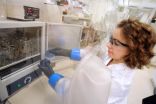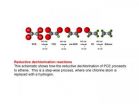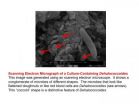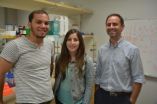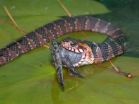(Press-News.org) Chlorinated chemicals perform a host of societally useful functions, but they also have a dark side. Once their use life has ended, such agents often become environmental contaminants, sometimes resistant to bioremediation.
In a series of new studies, Anca Delgado, a researcher at Arizona State University's Biodesign Institute, examines unique groups of microorganisms, capable of converting hazardous chlorinated chemicals like trichloroetheene (TCE) into ethene, a benign end product of microbial biodegradation.
The research was conducted as part of her doctorate work under the guidance of associate professor Rosa Krajmalnik-Brown at Biodesign's Swette Center for Environmental Biotechnology. Results of the most recent of three studies appear in the current, advanced online edition of the journal PLOS ONE.
The new studies explore the metabolic activities of a group of microbes known as Dehalococcoides, and propose strategies to improve their effectiveness for environmental cleanup projects involving chlorinated chemicals.
"Dehalococcoides have been officially on the scientific map since 1997," Delgado says, noting that they remain the only microorganisms of their kind, and therefore of great importance for bioremediation. "In close to 20 years we have not discovered other bacteria that can perform reductive dechlorination of chemicals like TCE all the way to ethene."
Trichloroethene – focus of the current studies – is one of the most ubiquitous chlorinated chemicals. Approximately 60 percent of the U.S. National Priorities List Superfund sites and roughly 20 percent of the national groundwater sources are contaminated with chlorinated solvents, such as TCE. TCE is a sweet-smelling, non-flammable liquid halocarbon that was widely used in the past century because of its properties as an effective industrial solvent, with applications ranging from dry cleaning to the cleaning and degreasing of an enormous range of metal and other components.
TCE produces many undesirable health side effects. The most alarming hazard associated with TCE exposure is cancer. In 2011, the United States Environmental Protection Agency revised its Final Health Assessment for Trichloroethylene, formally identifying TCE as a human carcinogen.
Improper disposal of TCE (and related chlorinated chemicals) is a major threat to human health and water sources due to the volume of these chemicals that have found their way into the environment, the resulting carcinogenic hazard and the significant challenges involved in cleanup.
Enter Dehalococcoides mccartyi, a group of anaerobic bacteria whose unique metabolic processes allow them to grow and thrive, using TCE as part of their respiratory machinery.
"They use these chlorinated solvents as their electron acceptor, which means they respire them," Krajmalnik-Brown says. "It's like their oxygen." (Just what Dehalococcoides was living on before the introduction of TCE remains an unresolved puzzle.)
Dehalococcoides have become an invaluable tool for the bioremediation of sites contaminated with TCE because they can convert the hazardous chemical first into cis-dichlroethene (cis-DCE), then to vinyl chloride, intermediary chlorinated byproducts, and finally into ethene, an environmentally benign, non-chlorinated end-product. As Krajmalnik-Brown notes "to date, every time we see a site where ethene is being produced, Dehalococcoides are present."
There's one problem, however. In some cases, Dehalococcoides fail to complete the transformation of TCE into ethene, stalling at the mid-stage reaction and sequentially producing two chemicals: cis-DCE and vinyl chloride. The latter is a human carcinogen and of grave concern in the environment, as it can disperse more readily than the original TCE.
The primary focus of the PLOS ONE study was to determine the nature of this stalling during the TCE-to-ethene reaction. Earlier studies had proposed that Dehalococcoides at a given bioremediation site lacked the necessary machinery required to complete the full breakdown of TCE into ethene. An alternate explanation suggested that Dehalococcoides was somehow inhibited during the process.
Delgado's work points to another explanation and a plausible means for rectifying the stalling problem. Dehalococcoides require hydrogen (H2) as an electron donor for their respiratory cycle. The current experiments proved that in some cases, Dehalococcoides are out-competed for hydrogen by a variety of other microorganisms present in the soil or sediment.
Samples of soil and sediment from three sites (Romania, Puerto Rico and South Carolina) were examined. The first two samples were uncontaminated while the third was extracted from a military base in Parris Island, South Carolina – a site contaminated with PCE, a chlorinated chemical similar to TCE.
All three samples were used in microcosm studies where general environmental conditions of a given site are replicated in a sample bottle and remediation effects can be acutely analyzed. The studies demonstrated that sites bearing wide microbial diversity (such as the uncontaminated Romanian and Puerto Rican samples) contained large numbers of bacteria capable of out-competing Dehalococcoides for essential hydrogen, thereby causing the breakdown of chlorinated chemicals to stall at the cis-DCE phase.
In the case of the contaminated sample from South Carolina, Dehalococcoides was successful in the full reduction of chlorinated chemical to ethene. The authors speculate that the toxic contaminant in the sediment likely acted to limit microbial diversity, allowing Dehalococcoides better access to hydrogen.
In the Romanian and Puerto Rican soil samples, conditions for Dehalococcoides to thrive were created by removing the soil with the competing microbes and their respective electron acceptors (presumably present in the solid phase). Thus, the mid-stage stalling was overcome and the reaction from TCE to ethene was successful. The same outcome was also obtained by enriching microcosms with additional Dehalococcoides from a mixed microbial culture.
A further discovery of the new research is that carbonate minerals naturally present in water and soil act as electron acceptors for competing microbes like methanogens and acetogens, helping them grow and outcompete Dehalococcoides for hydrogen. This was also systematically demonstrated in Delgado's previous study. Limiting the addition of carbonates (commonly used to raise the aquifer pH) in contaminated sites should also enhance the ability of Dehalococcoides to fully reduce TCE to ethene.
Delgado and her colleagues used the knowledge gathered in these two studies to grow biodegrading cultures in continuous bioreactor experiments, demonstrating that Dehalococcoides could be grown at high density and perform reductive dechlorination at faster rates under conditions where bicarbonate was finely adjusted to optimum values, depriving competitors (paper). Currently, Delgado and Krajmalnik-Brown are contacting bioremediation companies to test these optimized Dehalococcoides-containing cultures at contaminated sites.
"One of the implications of this study that we consider important is understanding your contaminated site – linking the chemistry and microbiology from the very beginning is very important," Delgado says. The stakes for human health are enormous, as effective cleanup of innumerable sites around the world contaminated with chlorinated chemicals remains a daunting societal challenge.
INFORMATION:
Written by: Richard Harth
Science Writer: The Biodesign Institute
Richard.Harth@asu.edu
Managing specialized microbes to clean stubborn chemicals from the environment
2014-06-26
ELSE PRESS RELEASES FROM THIS DATE:
Peanuts don't panic parents as much as milk and eggs
2014-06-26
ARLINGTON HEIGHTS, Ill. (June 26, 2014) – It's tough being the parent of a child with food allergies. Constant vigilance is needed for everything your child eats, when a single food item containing a hidden ingredient can be fatal. Although worry is a factor for anyone caring for a child with food allergies, according to a study published in the July issue of Annals of Allergy, Asthma and Immunology, the scientific publication of the American College of Allergy, Asthma and Immunology (ACAAI), there is increased anxiety and strain for caregivers of children allergic to milk ...
To avoid interbreeding, monkeys have undergone evolution in facial appearance
2014-06-26
Old World monkeys have undergone a remarkable evolution in facial appearance as a way of avoiding interbreeding with closely related and geographically proximate species, researchers from New York University and the University of Exeter have found. Their research provides the best evidence to date for the role of visual cues as a barrier to breeding across species.
"Evolution produces adaptations that help animals thrive in a particular environment, and over time these adaptations lead to the evolution of new species," explains James Higham, an assistant professor in ...
A breakthrough for organic reactions in water
2014-06-26
Green-chemistry researchers at McGill University have discovered a way to use water as a solvent in one of the reactions most widely used to synthesize chemical products and pharmaceuticals.
The findings, published June 26 in Nature Communications, mark a potential milestone in efforts to develop organic reactions in water.
Chao-Jun Li and Feng Zhou of McGill's Department of Chemistry report that they have discovered a catalytic system which for the first time allows direct metal-mediated reactions between aryl halides and carbonyl compounds in water.
For the past ...
Research says TB infection may be underestimated among people taking corticosteroid pills
2014-06-26
TORONTO, June 26, 2014—Tuberculosis infection among people taking corticosteroid pills may be underestimated, new research suggests. Current guidelines for what constitutes a positive TB skin test among corticosteroid pill users may not be capturing all those who are infected, said Dr. Nicholas Vozoris, a respirologist in the Tuberculosis Program at St. Michael's Hospital.
Previous research has shown that people who take corticosteroid pills, such as Prednisone, and have inhaled the TB bacteria, have an eight times higher risk of the bacteria becoming active than people ...
Men and women use mental health services differently
2014-06-26
TORONTO, June 26, 2014 – Women with chronic physical illnesses are more likely to use mental health services than men with similar illnesses; they also seek out mental health services six months earlier than those same men, according to new study from St. Michael's Hospital and the Institute for Clinical Evaluative Sciences (ICES).
"Chronic physical illness can lead to depression," said Dr. Flora Matheson, a scientist in the hospital's Centre for Research on Inner City Health. "We want to better understand who will seek mental health services when diagnosed with a chronic ...
Continued use of low-dose aspirin may lower pancreatic cancer risk
2014-06-26
PHILADELPHIA — The longer a person took low-dose aspirin, the lower his or her risk for developing pancreatic cancer, according to a study published in Cancer Epidemiology, Biomarkers & Prevention, a journal of the American Association for Cancer Research.
"We found that the use of low-dose aspirin was associated with cutting the risk of pancreatic cancer in half, with some evidence that the longer low-dose aspirin was used, the lower the risk," said Harvey A. Risch, MD, PhD, professor of epidemiology in the Department of Chronic Disease Epidemiology at the Yale School ...
Revisions needed for current IV feeding safeguards against bloodstream infections
2014-06-26
Current guidelines to help prevent bloodstream infections during intravenous feeding may need
revisions to strengthen protections for patients, a new study finds.
Researchers at the United Kingdom's University of Southampton found that current guidelines do not account for other independent factors that can affect the growth of potentially deadly microorganisms. Their study was published today in the OnlineFirst version of the Journal of
Parenteral and Enteral Nutrition (JPEN), the research journal of the American Society for Parenteral and Enteral Nutrition (A.S.P.E.N.). ...
Researchers call for patients who receive home nutritional care to have emergency plans
2014-06-26
On the heels of the 2014 hurricane season, researchers are calling for home parenteral and enteral nutrition (HPEN) consumers and their homecare providers to have a comprehensive emergency preparedness plan (EPP) to ensure that special needs are met during the time of a disaster.
In a paper published today in the American Society for Parenteral and Enteral Nutrition's (A.S.P.E.N.) Nutrition in Clinical Practice journal, researchers with Coram Specialty Infusion Services outline the experiences of HPEN consumers and homecare providers in New Jersey affected by Hurricane ...
Researchers discover 'Trojan Horse' method of penetrating cellular walls without harm
2014-06-26
COLLEGE STATION – Scientists with Texas A&M AgriLife Research have found a "Trojan horse" way to deliver proteins into live human cells without damaging them.
The finding, published in this month's Nature Methods, is expected to be easily adopted for use in medical research to find cures and treatments for a wide range of diseases, according to the team's lead scientist, Dr. Jean-Philippe Pellois, an associate professor of biochemistry at Texas A&M University.
"This is something that for many years people have tried to do, because proteins are basic components of the ...
Invasive watersnakes introduced to California may pose risk to native species
2014-06-26
Watersnakes, commonly seen in the lakes, rivers and streams of the eastern United States, are invading California waterways and may pose a threat to native and endangered species in the state, according to a University of California, Davis, study.
While scientists do not know exactly how many watersnakes are in California, roughly 300 individuals of two different species –the common watersnake and the southern watersnake -- have been found in the Sacramento area (Roseville and Folsom), and at least 150 were seen in Long Beach. Researchers suspect the nonvenomous snakes ...
